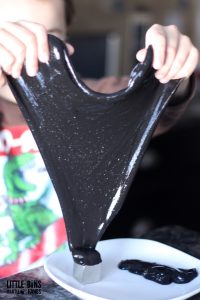Abstract:
Our project aims to teach children about magnetism, simple circuits, and non-Newtonian fluids by transforming a popular form of childhood entertainment: slime. We will begin by discussing the properties of magnets, iron oxide, and non-Newtonian fluids, followed by helping the children make their own magnetic slime from scratch. They will then each be given neodymium magnets with which they will observe how the magnetic slime acts when near them. Afterwards, they will discover that they can make their own magnets: electromagnets. We will teach very simple circuits, such as the importance of not shorting a battery, and afterwards each student will make their own electromagnets to use with their slime. Finally, we will end with a demonstration of our Arduino-powered magnetic slime controller. With a press of a button, the slime in our box moves whichever way we wish!
1. What is the concept the children will learn?
The students will learn about magnetism, such as north and south poles, and about non-Newtonian fluids.
2. What will the children do and how will they learn by interacting with your project?
The children will be given materials and instructions to each make their very own magnetic slime. They will be then given a magnet to play around with the magnetic slime to understand how the different poles of their magnet affects the slime.
Afterwards, we will introduce what an electromagnet is, and then they will each make one. They will test out their electromagnet with their magnetic slime.
They will learn that slime is a non-newtonian fluid. A non-newtonian fluid is neither a liquid or a solid. It can be picked up like a solid, but it also will ooze like a liquid, so slime does not have its own shape. Slime can also change its shape to fill whatever container it is in. However, it can also be bounced like a ball because of its elasticity.
They will also learn about polymers and how the slime activators change the polymers through cross-linking. They will also learn that slime is a sheer-thickening fluid, so pulling it hard makes it snap and pulling it slowly makes it stretch.
3. How does your project meet the requirements given above?
Yes, our project does. Slime is appealing to children of all ages, and they will each be excited to be able to make their own. Our electronic component is the electromagnets, and all materials can fit in a shoe box.
4. What supplies will be needed? What needs to be manufactured? If appropriate, include a sketch of the activity.
Elmer’s glue, borax, iron oxide powder, water, measuring cups, 9 volt batteries, nails, copper wire, electrical tape, an Arduino, neodymium magnets, and bowls will be needed. We will 3D print a demo box that will have electromagnets and an Arduino, with which we will show students how we can move the magnetic slime with the touch of a button.

https://littlebinsforlittlehands.com/make-magnetic-slime-iron-oxide-powder/